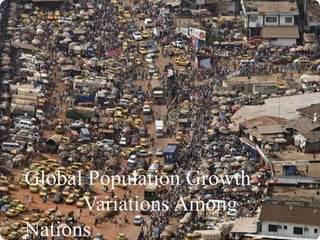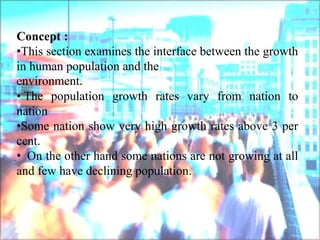Global Population Growth :Variations Among Nations
- 1. Global Population Growth : Variations Among Nations
- 2. Concept : ŌĆóThis section examines the interface between the growth in human population and the environment. ŌĆó The population growth rates vary from nation to nation ŌĆóSome nation show very high growth rates above 3 per cent. ŌĆó On the other hand some nations are not growing at all and few have declining population.
- 3. Global Human Population: ŌĆó The global human population at present is around 6 billion. It will cross the 7 billion mark by 2015. ŌĆó The world population is growing by more than 90 million per year. ŌĆó Present projections show that if our population growth is controlled, it will still grow to 7.27 billion by 2015. ŌĆó However, if no action is taken it will become a staggering 7.92 billion It is not the demographic figures alone that need to be stressed, but an appreciation of the impact of this demographic growth on natural resources.
- 4. ŌĆó The needs of this huge number of human beings cannot be supported by the EarthŌĆÖs natural resources, without degrading the quality of human life. U.S estimation: As of today's date, the world population is estimated by the United States Census Bureau to be 7.011 billion. ŌĆó The US Census Bureau estimates the 7 billion number was surpassed on 12 March 2012. According to a separate estimate by the United Nations,
- 5. Population Growth Among Nations: In 1800 the vast majority of human population i.e., 86% resided in Asia and Europe with 65% alone in Asia. ŌĆó In 2000 the world had 610 crore population which is expected to increase up to 10 billion by the year 2050 if the same trend continues. ŌĆó Some terms which are frequently used with population growth are ŌĆó. Birth rate: the no of live births per 1000 population in a given year.
- 6. ŌĆó EarthŌĆÖs population exceeded 7 billion in October 2011, a milestone that offers unprecedented challenges and opportunities to all of humanity, according to UNFPA, the United Nations Population Fund. ŌĆó According to papers published by the United States Census Bureau, the world population hit 6.5 billion (6,500,000,000) on 24 February 2006. ŌĆó The United Nations Population Fund designated 12 October 1999 as the approximate day on which world population reached 6 billion. This was about 12 years after world population reached 5 billion in 1987, and 6 years after world
- 9. ŌĆó Growth rate: the no of persons added to a population in a year due to natural increase. ŌĆó Doubling time: the no of years required for the population of an are to double its present size.
- 12. Decrease of Death Rate: Improved medicine, sanitation and nutrition have produced a major decrease in death rates. ŌĆó Between 1940 and 1960, the falling death rates in Egypt caused average life expectancy to increase by 20 yrs. ŌĆó Most western countries have low birth rates that their populations are approaching stability.
- 13. ŌĆó The united states population doubled from 135 million to 270 million during the past 60 yrs and is expected to increase up to 540 million in the next 70 yrs at a current t rate of 1%/yr. chinaŌĆÖs population is increasing at a rate of 1.1%/yr. ŌĆó IndiaŌĆÖs current population growth rate is 1.9% / yr. together china and India constitute more than 1/3rd of the world population.
- 14. Effects on Natural Resources: In the near future, fossil fuel from oil fields will run dry ŌĆó Existing agro systems will become too overburdened and will not be able to meet the demands for food. ŌĆó Pastures will be overgrazed by domestic animals. ŌĆó The industrial growth required to meet the demands of the massively rising population will reinforce pollution of soil, water and air. Industrial gases in particular will cause greater global warming and will eventually lead to a rise in sea levels, flooding all low-lying areas and submerging coastal agriculture as well as towns and cities
- 15. ŌĆó. The seas will experience a decline in the fish population. ŌĆóLarger ozone holes will develop due to the discharge of industrial chemicals into the atmosphere; this development in its turn will affect human health. ŌĆóThe population pressure will contribute to water the depletion of fresh water and may lead to water ŌĆśfaminesŌĆÖ. ŌĆóThe demographic pressure will also reinforce the degradation of ecosystems leading to extinction of thousands of species which have a great role in the sustainability of the planet.

















